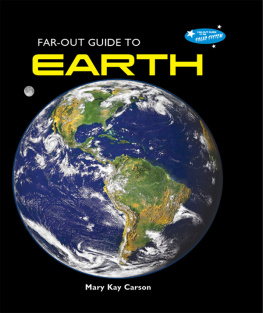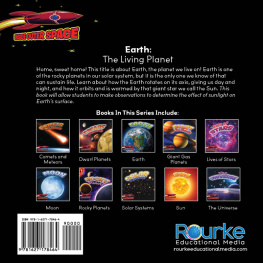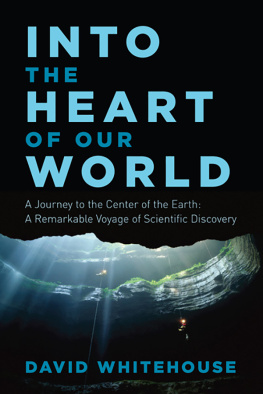EARTH, THE SAPPHIRE PLANET
Url Lanham
DOVER PUBLICATIONS, INC.
Mineola, New York
Copyright
Copyright 1978 by Url Lanham
All rights reserved under Pan American and International Copyright Conventions.
Published in Canada by General Publishing Company, Ltd., 30 Lesmill Road, Don Mills, Toronto, Ontario.
Published in the United Kingdom by Constable and Company, Ltd., 3 The Lanchesters, 162164 Fulham Palace Road, London W6 9ER.
Bibliographical Note
This Dover edition, first published in 1999, is an unabridged republication of The Sapphire Planet, the work originally published in 1978 by Columbia University Press, New York.
Library of Congress Cataloging-in-Publication Data
Lanham, Urless Norton, 1918
Earth, the sapphire planet / Url Lanham. Dover ed.
p. cm.
Originally published: The sapphire planet. New York: Columbia Press, 1978.
Includes index.
ISBN 0-486-40677-6 (pbk.)
1. Earth sciences. 2. Earth. I. Lanham, Urless Norton, 1918 The sapphire planet. II. Title.
QE31.L33 1999
550dc21
9843891
CIP
AC
Manufactured in the United States of America
Dover Publications, Inc., 31 East 2nd Street, Mineola, N.Y 11501
Peace in men, Good will toward Earth.
M. L.
Contents
INTRODUCTION
A FTER AN ACTIVE but carefree life of several billion years, the earth, with the appearance of mankind, has become self conscious, aware of her past, thoughtful of the future. She has seen herself in a mirror, in the photos taken from spacecraft. She is a sparkling gem of a planet with swirling veils of white shining clouds.
The self-image of the earth has grown and changed with the quarter-million-year history of human knowledge. During the immense preliterate era it was the land of the Tribe, whether jungle, desert, or the sounding seashore. With the written word, and travels over seas and continents, a civilized elite fashioned a universal picture. The image of the earth came to be shaped according to the cosmopolitan experiences of science. From the elite, the picture is reflected to the Tribe in books, schools, radios, electronic screens. Although always to a degree subjective, the human consciousness of the nature of the world is now solid with innumerable experiences, with hard contact that shapes both the people and the land.
ONE
THE OASIS
T HE VISIBLE UNIVERSE is sprinkled with shining, spherical atomic furnaces, the stars. According to a recent educated guess, about one-third of the stars are the centers of flat, rotating discs of cosmic dust and debris, in which are embedded one or more spherical planets. Such a star and its attendant planets make up a solar system. The nuclear star of our solar system is the sun, or Sol. A superficial glance at our solar system would perhaps see it as a sun and two planets, Jupiter and Neptune, which are so much larger than the rest that they contain 20 times the volume of the other seven planets combined. Orbiting about 93 million miles (150 million kilometers) out from the sun is the earth. Five times farther from the sun is the immense planet Jupiter. It is believed that halfway between our sun and the nearest star there are in orbit some billions of tailless comets, which are very cold snowballs, at perhaps 455 F (270 C, almost absolute zero), and maybe averaging half a mile (a kilometer) in diameter. Occasionally one of these, disturbed by gravitational fields of nearby stars, is sent into the vicinity of the sun, where part of its substance vaporizes into an immense luminous tail pushed outward by the solar wind.
Of all the planets in our solar system, only the earth has a surface temperature (average, 72 F or 22 C) which is both relatively stable and mostly within the range at which water exists as a liquid. Venus, nearer the sun, has a surface temperature of about 900 F (500 C). The small amount of water present is a hot sulfurous steam, and perhaps there are ice crystals in the frozen clouds at the top of the atmosphere. Mars, on the side of the earth away from the sun, has almost no water, and the mean surface temperature is 10 F (23 C). Liquid water may exist temporarily and locally at sun-warmed places on the surface. On the cloudy surfaces of the large planets beyond Mars the temperatures are even loweron the most distant planets, not much above the 455 F (270 C) of outer space.
Only the earth, of all our planets, has large volumes of water at the surface. Convenient for us, and all other living creatures. Water is essential to the existence of the mazy architecture of the intricate molecules whose activity produces life.
Is the earth also the only oasis in the universe? There are billions of stars in a galaxy, and there are galaxies at least by the billions. Theories of resonance in the aggregation of discs of debris around a sun, although still primitive, suggest that it would be by no means unusual to have an earth-sized planet at an earthlike distance from a central sun. However, a here-and-now in our solar system means little in terms of a there-and-now at interstellar and interglactic distances. The barriers of space and time are difficult to penetrate, and the question at the beginning of this paragraph has little meaning for us, or for me at least, at the time of writing.
The Subtle Substance
Water, or liquid dihydrogen oxide, is according to its textbook description colorless in thin layers and blue-green in thick ones. There is a story that the eminent nineteenth-century German scientist Hermann von Helmholtz had concluded from its behavior in electric fields that water was necessarily blue. To demonstrate for his students that water was inherently blue, not just reflecting the azure sky, he is said to have set up a long glass tube filled with distilled water, but when he looked through the apparatus, it did not look blue to him. So for the benefit of all, he added a tinge of blue dye. Now, von Helmholtz is so towering an intellectual figure in both physics and the physiology of sense perception that the story is likely apocryphal; but on the other hand it might be an unexpected glint of humor.
Nevertheless, the chemists are right, and the intense blue of the ocean as seen from a boat far beyond the turbid coastline is the color of the immense volume of water beneath. Since the ocean covers 70 percent of the earth, it should have come as no surprise that ours is a sapphire planet, yet the first photos taken far out in space by the men who coasted to the moon astonished us with the image of the earth as a glowing, gemlike blue planet, banded with gleaming white clouds of water vapor.
Liquid water is a light, mobile, clear substance, flowing in the infinitely varied patterns of brooks, rounding into drops of rain that refract sunlight into rainbows; at subfreezing temperatures it crystallizes into fragile snowflakes. It is a remarkable chemical compound. Strikingly different from other substances, says the chemist.
Water is one of the few compounds, if not the only one, that is a liquid, solid, or gas at ordinary temperatures, the temperatures at which we usually function. It is a gas, in varying proportions, in the atmosphere. Ice forms when the temperature drops below 32 F (0 C), and crusts the northern and far southern lands in winter. It forms layers miles deep on Greenland and the Antarctic continent, holding in cold storage most of the fresh water of the world. Liquid water exists, at the atmospheric pressure of sea level, only in the narrow temperature band of 32 to 212 F (0 to 100 C). In the solar system, as a whole, omitting the temperatures in the interior of the sun, the span of temperature ranges from 455 F (270 C) in outer space to nearly 11,000 F (6,000 C) at the surface of the sun.
Next page








